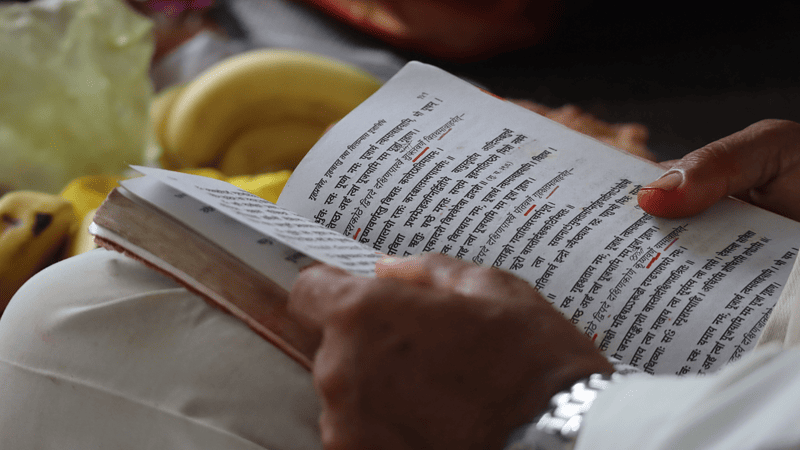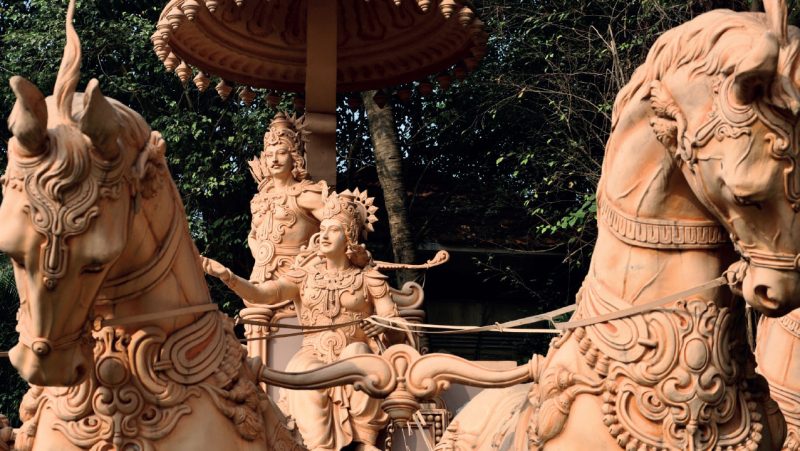
The Bhagavad Gita in 2021
The Bhagavad Gita in 2021: musings of a YTT200 student. By Hannah Godfrey
Studying for my 200-hour yoga teacher training (YTT) has been a fascinating experience and not just for my asana practice. In the course, we have a section about the history and philosophy of yoga which gives you a whole new view of the roots of this beautiful practice.
The Bhagavad Gita is the sixth book of the Mahabharata, one of India's most famous epic poems. It is said to have been written somewhere between 400BCE and 200CE.
The Gita tells us the dialogue between Arjuna, one of five Pandava princes, and the Hindu deity Krishna, who serves as Arjuna's charioteer. The conversation takes place in the middle of a battlefield as Arjuna prepares to battle his friends, family, and teachers. They speak of the karma, jnana and bhakti yogas, as well as the nature of divinity, humankind's ultimate destiny, and the purpose of mortal life.
It’s said that when we read the Gita, we are drawn to different parts depending on where we are in our lives, what we are experiencing in the present and what we have been through. What you learn from it can change from one day to the next.
The wonders of life
During my course, students were asked to pick a chapter from the Gita and write an essay on what it teaches us. I was immediately drawn to Chapter 11 – Cosmic Vision.
In this chapter, we are given a vision of the glory and splendour that is the universe, something that I don't think we could ever fully understand as human beings.
I think I was drawn to this chapter because of the circumstances that we find ourselves in at the moment; experiencing a rolling cycle of lockdowns because of the Covid-19 outbreak.
During the first lockdown, however, in the spring and summer 2020, it gave us all an opportunity to slow down. We were able to appreciate the smaller things as we were asked to stay indoors and started spending more time with our families, much more than we would usually on day-to-day basis.
For me, this was a time of being able to fully immerse myself in the things that I enjoy doing, such as studying, being creative and a big part of that was to be outside in nature and appreciate our environment — as well as taking the plunge into yoga teacher training!
I'm lucky enough to live on farmland, deep in the Oxfordshire countryside, so I could be outside in the sunshine most days and notice all the things that I haven't fully noticed before.
But, during this time I was also, unfortunately, shown the dark side of the world. We were losing people to the coronavirus, people were getting ill, the BLM movement and riots started across the world; it was also a very bleak and challenging time for so many people.
Our beautiful world
In the Gita, Arjuna describes all the things he sees, Thousands of facial features, countless smiles and eyes, clothes adorned with ornaments of beauty never seen before.
He goes on to describe seeing planets, living beings, stars, animals, and the plant kingdom. I love this imagery so much. It is so hard to fathom the abundance on earth, let alone the stars, planets and beyond.
This is why I enjoyed reading these few verses, because they take you out of what is happening in the world right now; it encourages you to think and imagine what Arjuna is seeing with this vision. Much like a guided meditation!
This is something I feel passionately about, recognising the complexity and beauty of life, the world we live in, and helping people to recognise that. Our planet is truly stunning, and we can experience so much beauty if we stop, think and look at what is around us. Even if we just look up at the sky for a moment or watch the birds outside on the grass.
Letting go
Arjuna is also taught the importance of letting go and accepting that our fate is that of the will of the universe. This is a spiritual teaching I myself have followed for a number of years and it has been profound.
When we let go of the need for control and believe that the universe ‘has our back’ it brings us so much inner peace and freedom.
Not only does this chapter of the Gita remind us that there must be balance, embracing the good and the bad, the light and dark, but also the beauty in letting go. (We find reference to this in the eight limbs of yoga, the final Niyama - Isvara Pranidhana which means to surrender.)
Yoga is far more complex than the asana themselves. It is a guide for living our best life and there are so many texts and writings available to study and reflect on.
If you haven’t read The Bhagavad Gita, add it to your bookshelf and when the urge takes you, pick a chapter and lose yourself for a while.
I’m not going to give you any spoilers as to what happens to Arjuna and Krishna, I’ll leave that up to you to discover — and perhaps, learn something new along the way!







